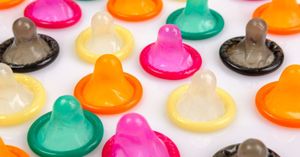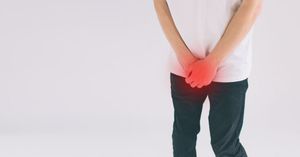It is critical to understand how to use a condom correctly in order to avoid pregnancy and the spread of sexually transmitted infections (STIs). This includes not only knowing how to insert an external (male) condom—rolling it down correctly and pinching the condom tip—but also how to open the packet and dispose of the used condom.
This can be difficult if you're using a condom for the first time and difficult for anyone who hasn't practised. And it pays to practise because condoms are an effective form of contraception (birth control) and STI prevention when used correctly and consistently.
This article discusses how to properly put on a condom.
1. Check the Use-by Date
The first thing you should do before putting on a condom is check the expiration date. If it is no longer current, throw it away and replace it with a current one. Checking the expiration date on the wrapper takes only a second, and once done, you're ready for step 2.
2. Open it Carefully
When opening the packet, use extreme caution. Push the condom to one side of the wrapper and tear it from the opposite corner, which has more space. This will prevent the condom from being damaged or ripped.
Quick tip: keep the condom away from sharp nails and jewellery when handling it!
3. Check the Condom is the Right Way Round
Next, make sure the condom is oriented correctly - the teat end should be pointing up. With your thumb and forefinger, grasp the teat. If you put it on the wrong side by accident, throw it away and get another one.
Precum contains semen; if you get it on the wrong side of the condom and continue to use it, the condom's effectiveness is lost.
4. Apply Teat End Up
We're almost ready to put the condom on, but first make sure the penis is fully erect. Pinch out any extra air between your thumb and finger to leave about a half-inch of extra space at the tip of the condom. The trapped air can cause the condom to split, which is not what you want.
5. Roll the Condom on
Simply roll the condom down to the base of the penis, smoothing out any air bubbles around the shaft as you go. It really is that simple. If you follow this simple step, you'll be ready to rumble, as they say.
6. Unroll the Condom All the Way
Once the condom is in place, unroll it to cover the entire shaft of the penis.
This will help to reduce the risk of transmission of any STIs transmitted through skin-to-skin contacts, such as syphilis. It also makes the condom less likely to slip than if it is only partially rolled down.
If the condom does not completely cover the shaft of the penis or feels too tight, it is too small. Using a condom that is too small or too large increases the likelihood of it failing.
7. Check for Trapped Air
There is air inside the condom if the tip feels like an inflated balloon. Leaving it there may increase the likelihood of the condom breaking during sex.
Place your hands around the penis and gently smooth out the condom from tip to base to release the air.
Putting a little lube in the tip of the condom before putting it on can sometimes help prevent this.
8. Hold the Condom When Withdrawing
Condoms should be carefully removed after ejaculation before the penis becomes less erect.
Hold onto the base of the penis as it is withdrawn from the vagina, anus, or mouth to keep the ejaculate inside. If the condom comes undone inside your partner, twist the open end shut before removing it.
If you don't do this, the condom may slip off or leak.
9. Throw Away the Condom
Condoms should be discarded, not flushed. (They are capable of clogging pipes.)
To keep the condom from leaking and making a mess, wrap it in toilet paper or a paper towel. It also better protects your privacy.
Summary
Condoms are an effective method of birth control and a simple way to avoid disease. However, in order for them to function properly, they must be used correctly.
Always check the expiration date and packaging before opening it. Make sure you unroll it right side out and leave room for the ejaculate when you put it on. When withdrawing from your partner, always keep it in place and discard the condom.
Following these best practices can help ensure that your condom is as effective as possible.
References
- Amy W. Anzilotti, MD, How Can You Tell if a Condom Has Expired? - https://kidshealth.org/en/teens/condom-check.html
- Condoms for masturbation? - https://goaskalice.columbia.edu/answered-questions/condoms-masturbation/
- The Dos and Don’ts of Condoms - https://playsafe.health.nsw.gov.au/2021/08/19/the-dos-and-donts-of-condoms/














